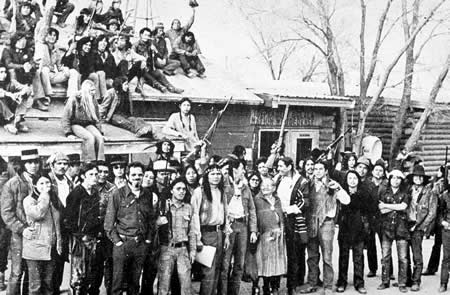 |
| American Indian Movement (AIM) |
Relations between Native peoples and U.S. federal and state governments soon after World War II swung between paternalism and indifference. Native Americans responded with a new militancy that echoed the Civil Rights movement and, by 1968, produced the American Indian Movement (AIM).
“Red power,” expressed in lawsuits, sit-ins, and demonstrations—some of them violent—created greater awareness of Native rights and fostered new economic and educational initiatives. But many Indians remained desperately poor and isolated.
In the 1950s federal policies reverted to a pre–New Deal relationship with Native tribes. Indians were once again urged to assimilate, giving up tribal political rights and long-standing land claims. Natives were encouraged to relocate from reservations to urban areas. More than 100 tribes were stripped of their sovereignty and benefits. The federal Bureau of Indian Affairs (BIA), never beloved but still useful to Native groups, lost much of its mission.
  |
This again changed dramatically in 1962 when President John F. Kennedy ushered in what became known as the Self-Determination Era. Kennedy was first in a series of presidents of both parties to take Indian cultural and economic claims more seriously. Natives benefited from Great Society programs. President Richard Nixon played a major role as a proponent of the 1974 Indian Self-Determination and Education Assistance Act.
By then the American Indian Movement was well under way. In 1969 AIM members occupied Alcatraz, the San Francisco Bay island formerly used as a federal prison. They would remain there, reclaiming Alcatraz as Indian land, for almost two years. In 1971 protesters briefly occupied Mount Rushmore, the South Dakota presidential monument near the 1876 site of a Sioux rout of General George Custer.
Not all AIM protests were peaceful. In 1973 a violent clash at Wounded Knee
The overall trajectory of U.S.-Native relations was toward greater autonomy and respect. Some “terminated” tribes, like the Menominee of the northern Great Lakes, had their authority restored. A 1971 Alaskan Native Claims Settlement Act and a 2000 restoration of 84,000 acres to Utah’s Ute tribe (accompanied by an official apology) advanced self-determination.
During the presidency of George H. W. Bush, almost 90 percent of BIA staff had tribal roots. U.S. courts, dusting off long-ignored treaties, restored many Native rights related to fishing, farming, travel, and sovereignty.
In 1979 Florida’s Seminole were the first to use court-affirmed rights to run bingo games. By the mid1990s more than 100 casinos were operating on reservation lands across the United States. Gaming and other new businesses, including tax-free sales of tobacco and other highly taxed products, enriched many tribes. Some assimilated Natives reaffiliated with their tribes to participate in this new economy.
But reliance on the greed of non-Indians proved no solution for fundamental inequities. Approximately 28,000 residents of Pine Ridge, the 3,500-square-mile Oglala Sioux reservation, live with high unemployment and annual family incomes below $4,000. High suicide and infant mortality rates have made life expectancy at Pine Ridge the nation’s shortest.
